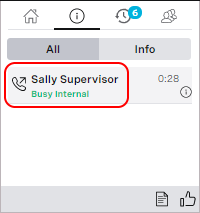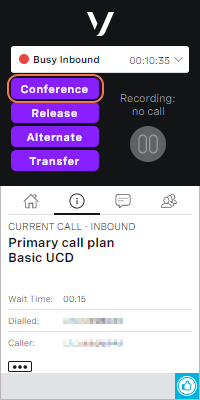How do I answer a call?
When you receive a call through the ContactPad you can make use of Vonage Contact Center's call control features; you can put the call on hold, consult with someone else, transfer the caller elsewhere or even control the call recordings.
When you receive an inbound call, the following things happen:
- your state automatically changes to Busy Inbound
- the call control buttons—Release, Hold, and Consult—become active
- the Pause button becomes available (if this feature is enabled for your account)
details of the inbound call appear in the information panel
Internal call
By default, if the inbound call is an internal call from another agent in your account, the agent's name will appear in the information panel.
- your phone starts to ring
If enabled for your account and in your browser, a web notification also appears. For more information, see Call notifications.
If you answer your phone, you are connected to the caller. If you cannot accept the call right now, you can reject it. For information about rejecting a call, see the How do I reject an incoming call? section later in this page.
You can now perform one of the following tasks:
- end the call. For information about ending a call, see How do I end an inbound call? later in this page.
- put the caller on hold. Click Hold to put the caller on hold. The caller hears on-hold music or beeps and the Hold button changes to a Retrieve button. Click Retrieve to speak with the caller again.
- consult with a third party—another agent, number, short code, queue or service—about this call, and, optionally, transfer the call to that third party. For information about consulting with a third party, see How do I consult with and, optionally, transfer to a third party? later in this page.
How do I reject an incoming call?
Before you are connected to a call, you can reject it. To reject a call when you receive an inbound call, click Release in ContactPad. The inbound call is then returned to the queue and routed to the next available agent.
After rejecting an inbound call your state automatically goes into No Answer.
How do I consult with and, optionally, transfer to a third party?
While on a call, you can consult with another agent or someone on another number about the call. If you have the Consult to Queue feature enabled for your account, you can also consult with a queue or service. More specifically, you consult with an available agent servicing the queue or service. For information about the Consult to Queue feature, see Consult to Queue. During consultation you can choose to transfer the call to the consulted agent, number, short code, queue, or service.
To consult with a third party about your current call, perform the following steps:
Click Consult. A new dialog box appears displaying all agents, queue names, service names, and agent groups in alphabetical order.
You can only consult with an agent who is in Available now or Interruptible status. For more information, see Extended agent presence (calls) in ContactPad.
Perform one of the following steps to find the VCC agent, agent group, interaction plan, short code, or other type of contact, you want to call:- Scroll down the list of agent, queue, service names, and agent groups using the arrow keys or mouse. Press Return, or click the name, to select the appropriate name.
- In the Search field, to filter the list, type part or all of the name of the agent you want to consult. Use the arrow keys or mouse to scroll down the filtered list to the agent. If the name is unique, it is selected automatically. Press Return, or click, to select the appropriate name.
In the Search field, type the telephone number of the person you want to consult.
A No matches found message appears when you type a telephone number. Ignore this message when consulting a telephone number.
In the Search field, to filter the list to include agent groups only, type '@' followed by part or all of the name of the group. Use the arrow keys or mouse to scroll down the filtered list to the group. Press Return, or click, to select group and display agent names from that group.
Typing '@' in the Search field removes everything other than groups in the list.
Optionally, in Callback number, select the callback number you want to present to the contact. For information about callback numbers, see Callback numbers.
- Press Return or click Dial to connect to the selected agent or the telephone number provided, or wait in the queue or service for an available agent to consult:
If you selected an agent or another number you will hear ringing until you are connected or until the consult times out.
The timeout for consulting with another agent or telephone number is configurable in System Settings. For information about configuring the timeout, see Editing System Settings.
Your caller hears on-hold music until you return to or transfer the call.
If you selected a queue or service and have the Consult to Queue feature enabled, the original caller is put on hold and hears on-hold music. You—the agent—enter and wait in the queue or service. For more information, see Consult to Queue. While waiting, you can click Alternate to switch between the queue and the original caller.
- If you selected a queue or service and do not have the Consult to Queue feature enabled for your account then the original call is transferred immediately to the selected queue or service.
When you are connected to the target agent or telephone number, or agent servicing the queue or service, the active call control buttons change.
Release, Alternate, and Transfer—become active.
- To end the consult connection, click Release. The active call control buttons change again. Retrieve and Consult—become active.
- To reconnect with the caller, click Retrieve. You are connected to the caller.
- To consult another agent or number, or to transfer the call to a queue or service, click Consult. Go to step 1.
- To transfer the caller to the consulted agent or number, click Transfer or hang up your telephone. The call is transferred and your state changes to Call Transferred for 5 seconds.
When you complete a Transfer, your state automatically changes to the Wrap Up state of Call Transferred.Information
The default timeout for the Call Transferred state is five seconds. Contact Vonage if you need to change this timeout.
To alternate between the caller and the consulted agent or number, click Alternate. You can alternate as many times as you require.
If you hang up your telephone without releasing the consult connection, your caller is transferred to the consulted number.
- To end the consult connection, click Release. The active call control buttons change again. Retrieve and Consult—become active.
How do I add another party to an existing inbound call (inbound conference call)?
While on an inbound call, if enabled for your account, you can add another participant to the call, for example another agent.
To add a third party to an existing inbound call, perform the following steps:
Click Consult to call the person you want to add to the conference (the consulted agent).
For information about consulting with a third party, see How do I consult with and, optionally, transfer to a third party? earlier in this page. When you are connected to the target number or agent, in addition to the usual buttons, the Conference button appears in ContactPad.
- Click Conference. All three parties can now hear each other.
- You can now perform one of the following tasks:
Disconnect the consulted agent and return to a two-way call with your customer. Click Release.
The same occurs if the consulted agent clicks Release in their ContactPad or hangs up their phone.Connect the consulted agent and the customer, and leave the call. Click Transfer or hang up your phone. The consulted agent now controls the call as described.
If the customer hangs up, you and the consulted agent remain in a two-way call.
When you are in a conference call, DTMF call control is unavailable. If enabled for your account, you and your customer can, however, use DTMF tones while in a conference call. The tones will play to all parties on the call. If you need to use DTMF tones in conference calls, contact your account manager.
How do I end an inbound call?
At the end of an inbound call, you can end the call in one of three ways:
- You, the agent, can click Release in ContactPad
- You, the agent, can hang up
- The caller can hang up
Following each call, your state is automatically changed to the Wrap up (Auto) state. This state takes you offline allowing you time to complete any activities for the call before your next call arrives.
The amount of time you have in the Wrap Up (Auto) state is automatically set by your supervisor, and can be different for each call type you receive.
If you set yourself to Wrap Up (Manual) you will remain in this state until you manually change your state again.
Following Wrap up (Auto) your state changes back to Ready or Ready for Outbound automatically. Whether you change to Ready or Ready for Outbound is determined by your supervisor. If your call center generally receives more inbound calls than makes outbound calls, the default ready state is likely to be Ready. If your call center makes more outbound calls than receives inbound calls, the default ready state is likely to be Ready for Outbound.
Click Ready at any time while in the Wrap Up state, ideally as soon as you are ready to take another call. Changing your state back to Ready as soon as possible helps your call center to answer more calls, and helps you to reduce your overall wrap up statistics.


